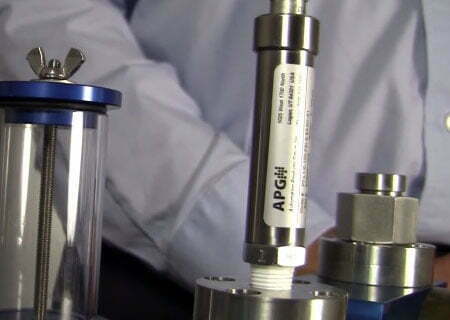 Catastrophic pressure transducer failure isn’t pretty or cheap, and at high pressure, little problems can turn big quickly. So let’s review the little things that need to be correct to ensure a long, effective (and safe!) life for your pressure transducer.
Catastrophic pressure transducer failure isn’t pretty or cheap, and at high pressure, little problems can turn big quickly. So let’s review the little things that need to be correct to ensure a long, effective (and safe!) life for your pressure transducer.
The pressure ratings of three components need to be greater than the expected system pressure: the line or vessel being monitored, the transducer, and the fitting attaching the pressure sensor to the line or vessel. This seems like Pressure System 101, and while ensuring the pressure rating of tank or pipe and pressure transducer exceeds the expected system pressure, the pressure rating of the fitting is sometimes overlooked.
For example, we’ve heard whispers and rumors of ½” NPT fittings being used over the recommended 10k psi. If your tank is rated for 20k psi, and you want a sensor rated for 20k psi, trying to connect them via a 10k psi fitting is asking for trouble on a system that experiences more than 10k psi.
Your pressure rating is only as high as the weakest component in the system.
Getting all of the pressure ratings in order is important, but it won’t matter if your sensor isn’t seated well. Pressure ratings are meaningless for crooked sensors.
For sensors with threaded process connections, start with thread tape or sealant. Make sure the tape is wrapped counter to the threads so it does not unravel while screwing the sensor into place.
Always start threading the sensor by hand to avoid cross-threading. Damaged threads can lead to faulty sensor installation.
Finally, never over-tighten your sensor. Over-tightening compresses the diaphragm, changing its response to pressure, which in turn, changes the readings from the sensor. Only tighten the sensor enough to create a safe, adequate seal. For pressure sensors with straight threads and an o-ring, tighten only until you can feel the o-ring compress. Continuing to tighten past that point will extrude or damage the o-ring, compromising the seal and functionality of the sensor.
This might seem like an unnecessary reminder, but having mismatched connections is dangerous in any industry. We don’t run into this very often, but it’s a mistake that can happen if labels and records aren’t clear.
This is a real threat in the oilfield, for example, where they use hammer union fittings. There are several parts that seem like they fit just fine, but aren’t meant for each other.
If you’re using hammer unions, make absolutely sure that the wing nut is the same Weco fitting code as the transducer! There are a few combinations of nuts and sockets that physically mate, but do not have matching pressure ratings. There are even more combinations that “almost fit.” Those are even more dangerous than the mismatched pairs, as an almost-fit pair will fail at a lower pressure than a mismatched pair.
OK, now that everything matches, and is in place, hammer that wing nut until it is tight. Hey, that’s why they call it a Hammer Union, right?
In any industry, mismatched connections are a recipe for disaster. If you have questions about pressure transmitters, or how to install them, give us a shout!
top photo credit: Thomas Leth-Olsen via flickr cc